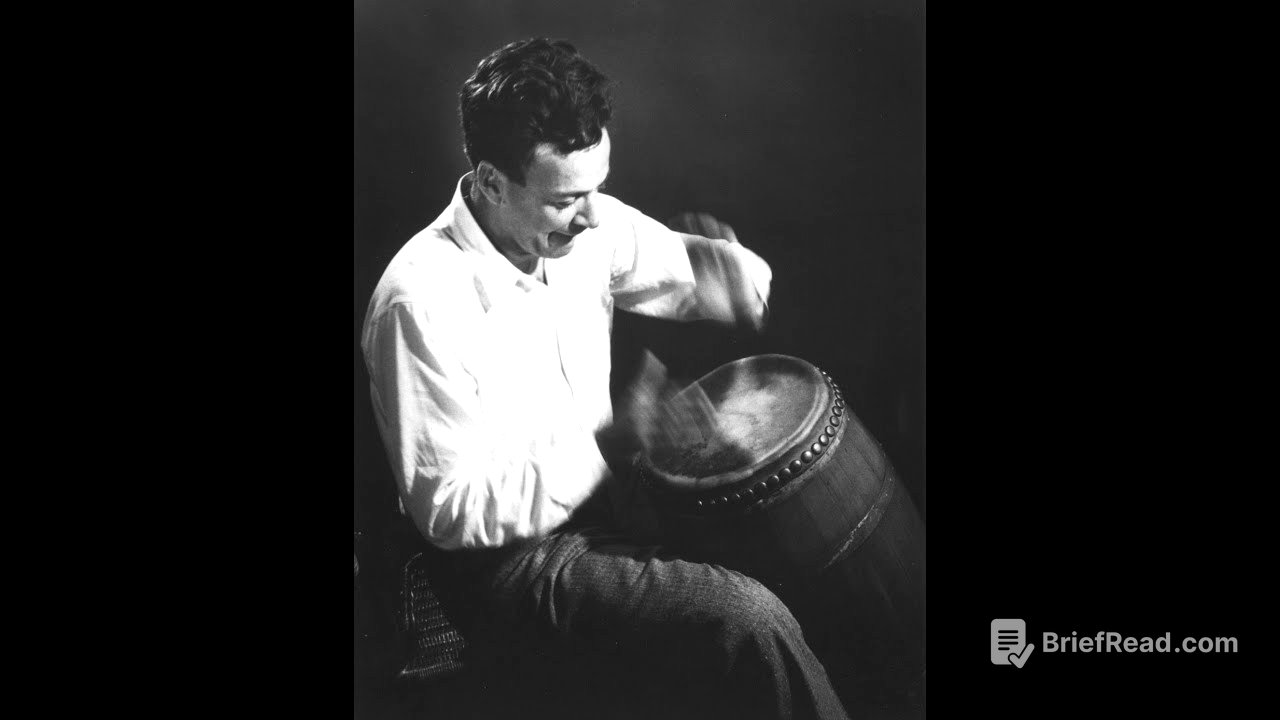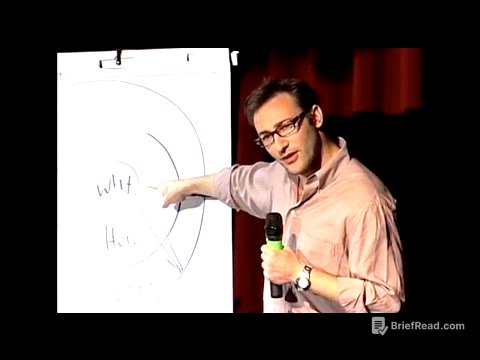TLDR;
This lecture introduces the atomic hypothesis, stating that all things are made of atoms in perpetual motion, attracting each other at a distance but repelling when squeezed together. It illustrates this concept by examining water in its various states (liquid, gas, solid) and processes like evaporation, dissolving, and chemical reactions, all from an atomic perspective. The lecture emphasizes the complexity and potential of arrangements of atoms, suggesting that even living beings can be understood as intricate, non-repeating arrangements of atoms.
- Atomic hypothesis: All matter is composed of atoms in constant motion.
- States of matter: Explained through the arrangement and motion of atoms.
- Processes: Evaporation, dissolving, and chemical reactions are viewed from an atomic perspective.
Introduction [0:00]
The lecture series will span two years and is presented from the viewpoint that the audience will become physicists. The field of physics has rapidly developed over the last two centuries, containing a vast amount of knowledge. Despite the extensive work, it's possible to summarize much of this knowledge into fundamental laws. The initial lectures will outline the relationship of physics to other sciences and the meaning of science itself. Each lecture will begin with a description of its purpose and a summary of the previous lecture.
Basic Laws and Approximations [2:19]
Physics cannot be taught by simply stating basic laws because we don't know all of them, and their correct statement requires unfamiliar ideas and advanced mathematics. Therefore, learning physics is a gradual process. Each piece of knowledge is an approximation to the complete truth, and much of what is learned will be corrected later. The principle of science is that experiment is the ultimate test of knowledge. Experiment provides hints, but imagination is needed to create generalizations and patterns, which must then be checked by experiment. There is a division of labor between theoretical physicists, who imagine and deduce new laws, and experimental physicists, who conduct experiments.
Approximate Nature of Laws [5:26]
The laws of nature are approximate, with initial findings often being incorrect before the right ones are discovered. An experiment can be "wrong" by being inaccurate. For example, the law stating that mass is constant regardless of speed was found to be incorrect at velocities approaching the speed of light. A more accurate law states that mass is constant to within one part in a million for objects moving less than a hundred miles per second. While the new law may seem to make little difference for ordinary speeds, it requires a complete alteration of our world picture philosophically.
Teaching Physics [7:12]
When teaching physics, a decision must be made whether to teach the correct, more exact law with its difficult conceptual ideas, or the simpler, approximate law. The former is more exciting, but the latter is easier to understand initially. This problem arises repeatedly in teaching physics, and it's important to know at each stage how accurate our knowledge is and how it fits into the broader context. The first three lectures aim to provide a general map of our understanding of science today. The purpose is to give a feel for the whole picture, so that when we focus on a particular point, we understand its background, significance, and how it fits into the larger structure.
Atoms in Motion: The Atomic Hypothesis [9:02]
The lecture begins with the atomic hypothesis: all things are made of atoms, which are small particles in perpetual motion, attracting each other at a distance and repelling when squeezed together. This single sentence contains an enormous amount of information about the world. The lecture aims to illustrate this idea.
Magnifying Water [10:16]
A drop of water appears smooth, but when magnified two thousand times, small football-shaped paramecia are visible. Magnifying the water material itself another two thousand times reveals a teeming crowd-like appearance. Further magnification shows two kinds of blobs: oxygen atoms (black) and hydrogen atoms (white), with each oxygen atom having two hydrogen atoms attached, forming water molecules. These particles are always in motion, jiggling, bouncing, and twisting around each other. They attract each other, forming a clump, but repel when squeezed too close.
States of Matter: Water, Steam, and Ice [14:36]
The water molecules stick together, maintaining the volume of the water. The motion of these molecules represents heat; increasing the temperature increases the motion. When heated, the jiggling increases until the molecules fly apart, creating steam. In steam, the molecules are more separated. The angle between the hydrogen atoms in a water molecule is 105 degrees, 3 minutes, and the distance between the hydrogen and oxygen atoms is 0.957 angstroms.
Gas Properties and Behavior [17:11]
Steam vapor, like any gas, consists of molecules bouncing against the walls, exerting pressure. The pressure is proportional to the density of the gas. Increasing the temperature increases the speed of the atoms, which also increases the pressure. When a piston compresses a gas, the atoms pick up speed, increasing the temperature. Conversely, when a gas expands, the atoms lose energy, and the gas cools.
Solid State: Ice [21:30]
Decreasing the temperature of water slows down the jiggling of the molecules. At very low temperatures, the molecules lock into a solid pattern, forming ice. In ice, the atoms are arranged in a crystalline array, with a definite place for every atom. This rigid structure allows ice to resist being pushed down at one end when held at the other, unlike water. The arrangement has a hexagonal symmetry, which accounts for the six-sided appearance of snowflakes. Ice shrinks when it melts because the structure has holes that can be occupied by molecules when the organization breaks down. Even in ice, the atoms jiggle in place, and increasing the temperature increases this jiggling until it melts. At absolute zero, there is a minimum amount of jiggling, but everything is solid except helium, which never solidifies unless pressure is applied.
Surface of Water and Evaporation [27:18]
At the surface of water, water molecules are always jiggling around. Occasionally, a molecule near the surface gets hit harder than usual and flies out, causing evaporation. Above the water, there is water vapor, oxygen molecules, and nitrogen molecules. In a closed vessel, water molecules leave the surface and come back, creating a dynamic equilibrium. If the vessel is opened and air is blown away, more molecules leave than come back, causing evaporation. The molecules that leave have more energy than average, cooling the liquid. Air can also dissolve in water, with nitrogen and oxygen molecules working their way into the water.
Dissolving Salt in Water [33:29]
When a crystal of salt is put in water, the salt ions (sodium and chlorine) get loose due to the attractions of the water molecules. The hydrogen ends of the water molecules surround the chlorine ions, while the oxygen ends surround the sodium ions. Whether the salt is dissolving or crystallizing depends on whether there is more or less salt in the water than the amount needed for equilibrium. Increasing the temperature generally increases the rate at which things dissolve, but this is not always the case.
Chemical Reactions: Burning Carbon in Oxygen [37:44]
In chemical reactions, atoms take up new combinations, forming new molecules. For example, carbon can burn in oxygen. Oxygen atoms stick together strongly in pairs. A carbon atom can combine with oxygen to form carbon monoxide (CO). This process releases a large amount of energy, generating heat and sometimes light. Carbon monoxide can further combine with oxygen to form carbon dioxide (CO2). The main difference between chemical and physical processes is that new partners are formed in chemical reactions, releasing a large amount of energy.
The Odor of Violets: Molecular Arrangement [41:59]
The odor of violets is caused by molecules that work their way into our nose. Chemists can analyze these molecules and determine the exact arrangement of the atoms. The air around a violet contains nitrogen, oxygen, water vapor, and the complex molecule responsible for the violet's odor. Chemical formulas are merely pictures of such molecules, showing which atoms are touching which. Chemists discover the arrangement of atoms by mixing substances and observing the results. The correct picture of the odor of violets is alpha irone, which has a specific arrangement of carbon, hydrogen, and oxygen atoms.
Evidence for Atoms and Complexity of Arrangements [49:16]
Evidence for atoms comes from the effects they produce. For example, the perpetual jiggling of tiny particles in water, known as Brownian motion, is direct evidence of the bombardment of atoms. Everything is made out of atoms, and the most important hypothesis in biology is that everything animals do, atoms do. The sheer complexity of arrangements of atoms, especially in living beings, is staggering. A pile of atoms which is not repeated from one to the other might well have the possibilities which you see before you.









